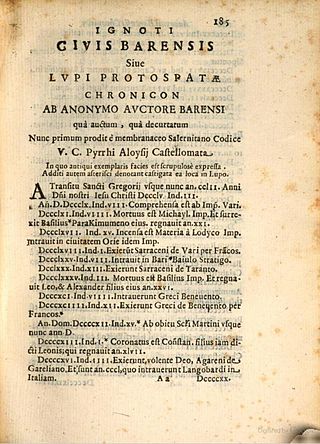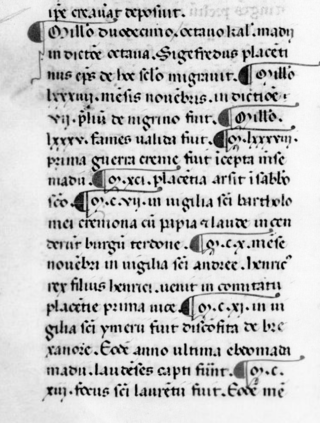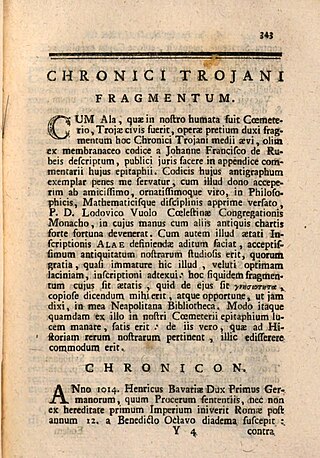
A chronicle is a historical account of events arranged in chronological order, as in a timeline. Typically, equal weight is given for historically important events and local events, the purpose being the recording of events that occurred, seen from the perspective of the chronicler. A chronicle which traces world history is a universal chronicle. This is in contrast to a narrative or history, in which an author chooses events to interpret and analyze and excludes those the author does not consider important or relevant.

The Chronicle of Moissac is an anonymous compilation that was discovered in the abbey of Moissac, but is now thought to have been compiled in the Catalan monastery of Ripoll in the end of the tenth century. Like most chronicles, it begins with Adam, but gains increasing interest for historians as it nears its end date of 828. Unfortunately, a folio with the entries covering the years 716–770 is missing. The only surviving manuscript of the Chronicle of Moissac dates from the later 11th century and is now in the French National Library in Paris.

The Royal Frankish Annals, also called the Annales Laurissenses maiores, are a series of annals composed in Latin in the Carolingian Francia, recording year-by-year the state of the monarchy from 741 to 829. Their authorship is unknown, though Wilhelm von Giesebrecht suggested that Arno of Salzburg was the author of an early section surviving in the copy at Lorsch Abbey. The Annals are believed to have been composed in successive sections by different authors, and then compiled.
Annalists, were a class of writers on Roman history, the period of whose literary activity lasted from the time of the Second Punic War to that of Sulla. They wrote the history of Rome from the earliest times down to their own days, the events of which were treated in much greater detail. Annalists were different from historians, in that an annalist was more likely to just record events for reference purposes, rather than offering their own opinions of events. There is, however, some overlap between the two categories and sometimes annalist is used to refer to both styles of writing from the Roman era.
The Deeds of the Saxons, or Three Books of Annals is a three-volume chronicle of 10th-century Germany, written by Widukind of Corvey. Widukind, proud of his people and history, begins his chronicon, not with Rome, but with a brief synopsis derived from the orally-transmitted history of the Saxons, with a terseness that makes his work difficult to interpret. Widukind omits Italian events in tracing the career of Henry the Fowler and he never mentioned a pope.
The Annals of Tigernach are chronicles probably originating in Clonmacnoise, Ireland. The language is a mixture of Latin and Old and Middle Irish.
Miriarcha is the name given in the Chronicon breve normannicum to the Byzantine general who led the defence of the Catapanate of Italy in 1060–1062. The anonymous chronicler has, however, misinterpreted the Greek title merarches as a name. The actual name of the general is unknown, and since the rank of merarches is not otherwise clearly attested in southern Italy his exact function is not known either. Probably the office was immediately below that of the catapan.
Sirianus was the Byzantine catapan of Italy, the second appointed by the Emperor Constantine X Doukas. He arrived in Bari, the seat of the catapanate, in 1061 or 1062, replacing Marules, who had been appointed the previous year. Constantine was the last emperor who took an interest in recovering ground in Italy, but Sirianus was on the defensive against the Norman state and recovered no territory. According to the annals of Lupus Protospatharius, the Norman duke Robert Guiscard captured Oria and Brindisi in the year of his appointment and Taranto in the following year. He was succeeded in 1064 by Abulchares.
Nikephoros Karantenos, Latinized as Nicephorus Carantenus, was a Byzantine general known for fighting against the Bulgarians in the Balkans and the Normans in Italy. The main sources for his life is the continuator of John Skylitzes, Lupus Protospatharius, and the Anonymi Barensis Chronicon.

The Annals of Quedlinburg were written between 1008 and 1030 in the convent of Quedlinburg Abbey. In recent years a consensus has emerged that it is likely that the annalist was a woman. The annals are mostly dedicated to the history of the Holy Roman Empire; they also contain the first written mention of the name of Lithuania ("Litua"), dated to March 1009. The original document has disappeared, surviving only as a 16th-century copy held in Dresden, but its contents endure as a scholarly resource.
Peter II was the third Italo-Norman count of Trani. He was the youngest of three sons of Peter I; his elder brothers were Amico and Geoffrey.

The Anglo-Saxon Chronicle is a collection of annals in Old English, chronicling the history of the Anglo-Saxons.

Anonymi Barensis Chronicon is a medieval Italian annalistic chronicle.
The Annales Barenses is an anonymous set of annals written in the city of Bari in the late eleventh century. At the time of its composition, Bari was the chief city of the Byzantine Empire in southern Italy.
Bisantius Guirdeliku was a noble citizen of Bari, then the capital of the Byzantine catepanate of Italy. He held the rank of patrikios. During the siege of Bari (1068–71) by the Normans, he led the faction opposed to surrender until he was assassinated by his rival, Argirizzo, in 1070. His nickname is known from the anonymous Annales Barenses and the chronicle of Lupus Protospatharius.

Annales Laurissenses minores or ALM is the Latin name of a medieval, historiographic text from the abbey at Lorsch near Worms in Germany. In many German texts, they are also called the Kleine Lorscher Frankenchronik, but in English may be referred to as the "Short chronicle of Lorsch" or "Lesser Annals of Lorsch".

The Guelph Annals of Piacenza is a Latin chronicle of Piacenza and Lombardy for the years 1031–1235, written by Giovanni Codagnello.

The Fragmentary Troia Chronicle is a short, anonymous Latin history of the south Italian city of Troia and the bishops of Troia in the 11th and 12th centuries. The text as it has come down is fragmentary and incomplete. It is a hybrid text, containing annals, a short hagiographical section and partial copies of charters. Due to the poor transmission of the text, its authenticity and reliability have been questioned.

Gertrude of Merania, the queen consort of Hungary as the first wife of King Andrew II, was assassinated by a group of Hungarian lords on 28 September 1213 in the Pilis Mountains during a royal hunting expedition. Leopold VI, Duke of Austria and Gertrude's brother Berthold, Archbishop of Kalocsa were also wounded but survived the attack.
Rerum italicarum scriptores ab anno æræ christianæ quingentesimo ad millesimumquingentesimum is a collection of texts which are sources for Italian history from the 6th to the 15th century, compiled in the 18th century by Ludovico Antonio Muratori.









